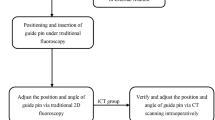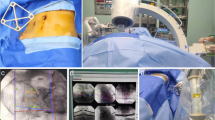Abstract
Purpose
This study aims to investigate the application value of O-arm navigation system in sacroiliac screw placement for the treatment of unstable pelvic ring injury.
Methods
A total of 40 patients (mean age = 30.75 ± 14.99 years, 25 males, 15 females) were included. From January 2016 to July 2018, 40 patients with posterior pelvic ring injury treated in our hospital were included. Of them, 19 patients underwent O-arm navigation for screw placement (O-arm group) while the other 21 received C-arm fluoroscopy guidance (C-arm group) for sacroiliac screw placement. Intraoperative outcomes and the outcome of screw placement were compared between groups. The quality of radiological images was assessed by Matta’s radiological outcome grade. The outcome of complex pelvic fracture treatment was evaluated by Majeed Functional score.
Results
All demographic and clinical characteristics were comparable between the two groups. Compared with the C-arm groups, the O-arm group had a shorter surgery time (33.19 ± 3.14 vs. 48.35 ± 4.38 min, P < 0.001), a higher overall good outcome “excellent + good” rate of screw placement (95.45% vs. 73.91%, P < 0.05), and a significantly higher Majeed Functional score better outcome of complex pelvic fracture treatment at 1 and 3 months postoperation (both P < 0.05).
Conclusion
Our results demonstrated that O-arm navigation system is feasible and safe for the treatment of posterior pelvic ring injury and can effectively improve the accuracy and safety of sacroiliac screw placement, shorten the operation time, and help rapid postoperative functional recovery.


Similar content being viewed by others
References
Ghosh S, Aggarwal S, Kumar V et al (2019) Epidemiology of pelvic fractures in adults: our experience at a tertiary hospital. Chin J Traumatol 22:138–141. https://doi.org/10.1016/J.CJTEE.2019.03.003
Saxena P, Agrawal A, Sakale H (2014) Introduction to pelvic injury and its acute management. J Orthop Traumatol Rehabil 7:1. https://doi.org/10.4103/0975-7341.133995
Richter PH, Gebhard F, Dehner C, Scola A (2016) Accuracy of computer-assisted iliosacral screw placement using a hybrid operating room. Injury 47:402–407. https://doi.org/10.1016/j.injury.2015.11.023
Briem D, Linhart W, Lehmann W et al (2006) Computer-assisted screw insertion into the first sacral vertebra using a three-dimensional image intensifier: results of a controlled experimental investigation. Eur Spine J 15:757–763. https://doi.org/10.1007/s00586-005-0992-5
Zwingmann J, Konrad G, Kotter E et al (2009) Computer-navigated iliosacral screw insertion reduces malposition rate and radiation exposure. Clin Orthop Relat Res 467:1833–1838. https://doi.org/10.1007/s11999-008-0632-6
De Silva T, Punnoose J, Uneri A et al (2018) Virtual fluoroscopy for intraoperative C-arm positioning and radiation dose reduction. J Med Imaging 5:1. https://doi.org/10.1117/1.JMI.5.1.015005
Zwingmann J, Hauschild O, Bode G et al (2013) Malposition and revision rates of different imaging modalities for percutaneous iliosacral screw fixation following pelvic fractures: a systematic review and meta-analysis. Arch Orthop Trauma Surg 133:1257–1265. https://doi.org/10.1007/s00402-013-1788-4
Moed BR, Ahmad BK, Craig JG et al (1998) Intraoperative monitoring with stimulus-evoked electromyography during placement of iliosacral screws: an initial clinical study. J Bone Jt Surg - Ser A 80:537–546. https://doi.org/10.2106/00004623-199804000-00010
Liu Z, Jin M, Qiu Y et al (2016) The superiority of intraoperative O-arm navigation-assisted surgery in instrumenting extremely small thoracic pedicles of adolescent idiopathic scoliosis. Medicine (Baltimore) 95:e3581. https://doi.org/10.1097/MD.0000000000003581
Rosenberger RE, Dolati B, Larndorfer R et al (2010) Accuracy of minimally invasive navigated acetabular and iliosacral fracture stabilization using a targeting and noninvasive registration device. Arch Orthop Trauma Surg 130:223–230. https://doi.org/10.1007/s00402-009-0932-7
Behrendt D, Mütze M, Steinke H et al (2012) Evaluation of 2D and 3D navigation for iliosacral screw fixation. Int J Comput Assist Radiol Surg 7:249–255. https://doi.org/10.1007/s11548-011-0652-7
Coste C, Asloum Y, Marcheix PS et al (2013) Percutaneous iliosacral screw fixation in unstable pelvic ring lesions: the interest of O-ARM CT-guided navigation. Orthop Traumatol Surg Res 99:S273–S278. https://doi.org/10.1016/j.otsr.2013.03.002
Ghisla S, Napoli F, Lehoczky G et al (2018) Posterior pelvic ring fractures: intraoperative 3D-CT guided navigation for accurate positioning of sacro-iliac screws. Orthop Traumatol Surg Res 104:1063–1067. https://doi.org/10.1016/j.otsr.2018.07.006
Hsu AR, Lee S (2014) Evaluation of tarsal navicular stress fracture fixation using intraoperative O-arm computed tomography. Foot Ankle Spec 7:515–521. https://doi.org/10.1177/1938640014532130
Majeed SA (1989) Grading the outcome of pelvic fractures. J Bone Jt Surg - Ser B 71:304–306. https://doi.org/10.1302/0301-620x.71b2.2925751
Qureshi S, Lu Y, McAnany S, Baird E (2014) Three-dimensional intraoperative imaging modalities in orthopaedic surgery: a narrative review. J Am Acad Orthop Surg 22:800–809
He J, Tan G, Zhou D et al (2016) Comparison of isocentric C-arm 3-dimensional navigation and conventional fluoroscopy for percutaneous retrograde screwing for anterior column fracture of acetabulum: an observational study. Medicine (Baltimore) 95:e2470. https://doi.org/10.1097/MD.0000000000002470
Takao M, Nishii T, Sakai T et al (2014) Iliosacral screw insertion using CT-3D-fluoroscopy matching navigation. Injury 45:988–994. https://doi.org/10.1016/j.injury.2014.01.015
Verma SK, Singh PK, Agrawal D et al (2016) O-arm with navigation versus C-arm: a review of screw placement over 3 years at a major trauma center. Br J Neurosurg 30:658–661. https://doi.org/10.1080/02688697.2016.1206179
Takao M, Nishii T, Sakai T, Sugano N (2013) CT-3D-fluoroscopy matching navigation can reduce the malposition rate of iliosacral screw insertion for less-experienced surgeons. J Orthop Trauma 27:716–721. https://doi.org/10.1097/BOT.0b013e31828fc4a5
Grelat M, Zairi F, Quidet M et al (2015) Assessment of the surgeon radiation exposure during a minimally invasive TLIF: comparison between fluoroscopy and O-arm system. Neurochirurgie 61:255–259. https://doi.org/10.1016/j.neuchi.2015.04.002
Guo N, Zhang H, Li J et al (2013) O-arm based navigation vs X-ray fluoroscopy in accuracy of pedicle drilling in bovine lumber spine specimens. J Third Mil Med Univ 35:277–279
Tow BPB, Yue WM, Srivastava A et al (2015) Does navigation improve accuracy of placement of pedicle screws in single-level lumbar degenerative spondylolisthesis? A comparison between free-hand and three-dimensional o-arm navigation techniques. J Spinal Disord Tech 28:E472–E477. https://doi.org/10.1097/BSD.0b013e3182a9435e
Pitteloud N, Gamulin A, Barea C et al (2017) Radiation exposure using the O-arm® surgical imaging system. Eur Spine J 26:651–657. https://doi.org/10.1007/s00586-016-4773-0
Su AW, Luo TD, McIntosh AL et al (2016) Switching to a pediatric dose O-arm protocol in spine surgery significantly reduced patient radiation exposure. J Pediatr Orthop 36:621–626. https://doi.org/10.1097/bpo.0000000000000504
Kassis SZ, Abukwedar LK, Msaddi AK et al (2016) Combining pedicle screw stimulation with spinal navigation, a protocol to maximize the safety of neural elements and minimize radiation exposure in thoracolumbar spine instrumentation. Eur Spine J 25:1724–1728. https://doi.org/10.1007/s00586-015-3973-3
Acknowledgments
We are grateful for the help from Professor Tan Haitao who is the secretary of the hospital’s party committee and the chief physician of orthopedics, as well as the help from the team of orthopedic surgeons.
Funding
This study is supported by the Inversion and Application of Scientific and Technical Payoffs of Guigang, Guangxi Province (GKZ 1701002), Guangxi Science and Technology Project (AD17129017, AD17195042), Guangxi Natural Science Foundation Project (2018GXNSFAA294129), the Key Clinical Specialty Construction Projects in Guangxi Zhuang Autonomous Region, and Guigang Scientific Research and Technology Development Projects (GKT 1834002).
Author information
Authors and Affiliations
Corresponding author
Ethics declarations
This study was approved by the institutional review board of our hospital. Written informed consent was obtained from each patient.
Conflict of interest
The authors declare that they have no conflict of interest.
Additional information
Publisher’s note
Springer Nature remains neutral with regard to jurisdictional claims in published maps and institutional affiliations.
Rights and permissions
About this article
Cite this article
Lu, S., Yang, K., Lu, C. et al. O-arm navigation for sacroiliac screw placement in the treatment for posterior pelvic ring injury. International Orthopaedics (SICOT) 45, 1803–1810 (2021). https://doi.org/10.1007/s00264-020-04832-2
Received:
Accepted:
Published:
Issue Date:
DOI: https://doi.org/10.1007/s00264-020-04832-2




